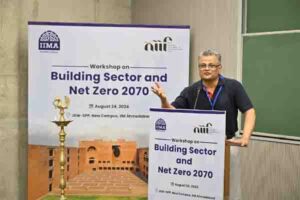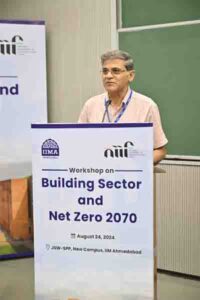- India and its building sector have to lead the world by showing how these challenges can be addressed: Professor Amit Garg, NIIF Chair Professor at IIMA
- When the social cost is much larger than the private cost, it is essential to have government interventions to support green initiatives by various stakeholders to address the growing environmental concerns: Professor Satish Deodhar, Dean of Faculty, IIMA
- To make the construction industry take initiatives towards green development, we will have to convince them with very strong data and policies: Sameer Sinha, Founder and MD, Savvy Group and Guest of Honour for the workshop
NE EDUCATION BUREAU
AHMEDABAD, AUGUST 25
India’s building sector needs integrated and proactive initiatives from the government and industry to be a lead contributor towards Net Zero 2070, said a think-tank here on Saturday.
They were speaking at a day-long workshop on “Building Sector and Net Zero 2070” at the Indian Institute of Management Ahmedabad (IIMA).

Context of the Workshop
India’s Nationally Determined Contribution (NDC) commitment to achieve Net Zero by 2070 necessitates decarbonisation of India’s economy in conjunction with being energy-independent by 2047. Decarbonising India’s economy requires decarbonisation of various sectors viz. power, transport, industry, building, and agriculture, etc. as they contribute to substantial Green House Gase (GHG) emissions in India.

India’s building sector accounts for 33% of its total final energy consumption, which is increasing at around 8% annually, due to increased housing and cooling space demand, higher appliance ownership, increased access to modern cooking fuels, and income effects. Building and construction sectors contributed around a third of GHG emissions (including operational as well as embodied emissions) in India. Its floor area is projected to increase more than 2.5 times i.e. from 16 billion m2 in 2015 to 58 billion m2 in 2050. The increase in floor space will add to its current stock of air-conditioners from 30 million units in 2018 to 240 million units in 2030 and more than 1100 million units in 2050. This will offer emerging opportunities to leapfrog to advanced building energy codes In this scenario, providing thermal comfort and reliable electricity to all citizens of India will be a key challenge., net-zero energy or carbon buildings, low-energy cooling innovations, energy-efficient technologies, and smart appliances, etc.
During the day-long workshop, the participants deliberated on various pertinent aspects of the subject, including integrated design approaches – challenges and opportunities; linking building sector, energy-efficient technology solutions and finance; role of green building rating programs; policy priorities in the building sector towards achieving Net Zero 2070, and so on.
Opportunities and Challenges
Key elements that can boost decarbonisation of building sector include increasing energy efficiency to reduce energy demand during its operation, reducing embodied energy to reduce its lifecycle emissions, increasing the use of renewable energy, accelerating retrofits through integrative building design, promoting the adoption of low-carbon practices, occupant behaviour, etc. However, there is a huge gap in policy implementation at various levels of the building sector in India which includes building design, use of energy-efficient technology solutions in buildings, energy-efficient and sustainable operation of buildings, etc.
Underlining the need for thoughtful planning and implementation for Net Zero in the building sector in India, Professor Amit Garg, NIIF Chair Professor at IIMA said, “With the rising demand for energy consumption in the building sector, it is high time that the government and building industry work in tandem to address the green building design and finance related challenges and tap the opportunities that can also benefit the building operators and users. Being a country with varying climates, we have to see how we can incorporate more elements of nature in our building designs and construction as per the climate in each region to reduce energy consumption. India and its building sector have to lead the world by showing how these challenges can be addressed.”
Advocating the importance of government intervention, Professor Satish Deodhar, Dean of Faculty, IIMA, said, “It is a fact that businesses need to work in competitive markets in order to succeed, which ultimately result in rapid growth of the country’s economy and GDP. At the same time, however, we also cannot shy away from the fact that free markets can adversely impact the environment and various stakeholders in the supply chain. And hence, when the social cost is much larger than the private cost, it is essential to have government interventions to support green initiatives by various stakeholders to address the growing environmental concerns. It is also important to have these kinds of dialogues between academia, researchers, industry practitioners, and government, to understand different perspectives and come up with intelligent solutions to suggest to the government.”
Giving an industry perspective, Sameer Sinha, Founder and MD, Savvy Group and Guest of Honour for the workshop, said, “In order to address the challenges of the building sector to proactively contribute towards Net Zero for India, we need to stop working in silos and collaborate more on design, engineering, and construction to achieve sustainable development. At the same time, it also has to make economic sense, and policy interventions can provide a level playing field for the same. While taking green building costs into account, we should also give enough consideration to the operational and life-cycle analysis of the buildings. To make the construction industry take initiatives towards green development, we will have to convince them with very strong data and policies. Green funding can also contribute a lot to the same. Another challenge in our country is that we treat natural resources like water and air as free and we need to change our mindset to reduce more adverse consequences for the planet.”












